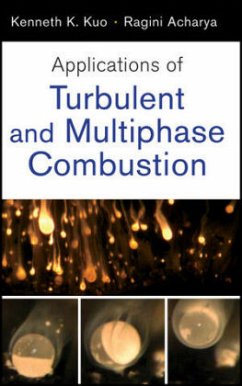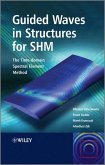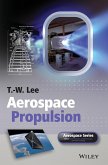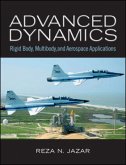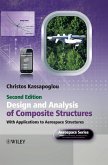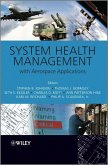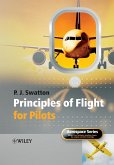- Gebundenes Buch
- Merkliste
- Auf die Merkliste
- Bewerten Bewerten
- Teilen
- Produkt teilen
- Produkterinnerung
- Produkterinnerung
This book is the second of two follow-on volumes to the author's bestseller, Principles of Combustion, Second Edition published in 2005. This text focuses on applications, with coverage not available elsewhere, including solid propellants, burning behavior, and chemical boundary layer flows. Kuo provides a multiphase systems approach beginning with more common topics and moving to higher level applications. As with Kuo's earlier book, large numbers of examples and problems and a solutions manual are provided.
Andere Kunden interessierten sich auch für
![Guided Waves in Structures for SHM Guided Waves in Structures for SHM]() Wieslaw OstachowiczGuided Waves in Structures for SHM141,99 €
Wieslaw OstachowiczGuided Waves in Structures for SHM141,99 €![Aerospace Propulsion Aerospace Propulsion]() T. W. LeeAerospace Propulsion107,99 €
T. W. LeeAerospace Propulsion107,99 €![Advanced Dynamics Advanced Dynamics]() Reza N. JazarAdvanced Dynamics170,99 €
Reza N. JazarAdvanced Dynamics170,99 €![Design and Analysis of Composite Structures Design and Analysis of Composite Structures]() Christos KassapoglouDesign and Analysis of Composite Structures117,99 €
Christos KassapoglouDesign and Analysis of Composite Structures117,99 €![System Health Management System Health Management]() System Health Management236,99 €
System Health Management236,99 €![The Global Airline Industry The Global Airline Industry]() The Global Airline Industry92,99 €
The Global Airline Industry92,99 €![The Principles of Flight for Pilots The Principles of Flight for Pilots]() Peter J. SwattonThe Principles of Flight for Pilots97,99 €
Peter J. SwattonThe Principles of Flight for Pilots97,99 €-
-
-
This book is the second of two follow-on volumes to the author's bestseller, Principles of Combustion, Second Edition published in 2005. This text focuses on applications, with coverage not available elsewhere, including solid propellants, burning behavior, and chemical boundary layer flows. Kuo provides a multiphase systems approach beginning with more common topics and moving to higher level applications. As with Kuo's earlier book, large numbers of examples and problems and a solutions manual are provided.
Produktdetails
- Produktdetails
- Verlag: Wiley & Sons
- 1. Auflage
- Seitenzahl: 600
- Erscheinungstermin: 1. Mai 2012
- Englisch
- Abmessung: 241mm x 161mm x 38mm
- Gewicht: 940g
- ISBN-13: 9781118127568
- ISBN-10: 1118127560
- Artikelnr.: 34449861
- Herstellerkennzeichnung
- Libri GmbH
- Europaallee 1
- 36244 Bad Hersfeld
- gpsr@libri.de
- Verlag: Wiley & Sons
- 1. Auflage
- Seitenzahl: 600
- Erscheinungstermin: 1. Mai 2012
- Englisch
- Abmessung: 241mm x 161mm x 38mm
- Gewicht: 940g
- ISBN-13: 9781118127568
- ISBN-10: 1118127560
- Artikelnr.: 34449861
- Herstellerkennzeichnung
- Libri GmbH
- Europaallee 1
- 36244 Bad Hersfeld
- gpsr@libri.de
Kenneth K. Kuo is Distinguished Professor of Mechanical Engineering and Director of the High Pressure Combustion Laboratory (HPCL) in the Department of Mechanical and Nuclear Engineering of the College of Engineering at The Pennsylvania State University.??Professor Kuo established the HPCL and is recognized as one of the leading researchers and experts in propulsion-related combustion. Ragini Acharya is Senior Research Scientist at United Technologies Research Center. She received her PhD from The Pennsylvania State University in 2008. Dr. Acharya's research expertise includes development of multiphysics, multiscale, multiphase models, fire dynamics, numerical methods, and scientific computing. She has authored or coauthored multiple technical articles in these areas.
Preface xvii 1 Solid Propellants and Their Combustion Characteristics 1 1.1 Background of Solid Propellant Combustion, 4 1.1.1 Definition of Solid Propellants, 4 1.1.2 Desirable Characteristics of Solid Propellants, 4 1.1.3 Calculation of Oxygen Balance, 5 1.1.4 Homogeneous Propellants, 6 1.1.4.1 Decomposition Characteristics of NC, 6 1.1.5 Heterogeneous Propellants (or Composite Propellants), 7 1.1.6 Major Types of Ingredients in Solid Propellants, 8 1.1.6.1 Description of Oxidizer Ingredients, 10 1.1.6.2 Description of Fuel Binders, 12 1.1.6.3 Curing and Cross-Linking Agents, 14 1.1.6.4 Aging, 15 1.1.7 Applications of Solid Propellants, 16 1.1.7.1 Hazard Classifications of Solid Propellants, 16 1.1.8 Material Characterization of Propellants, 16 1.1.8.1 Propellant Density Calculation, 16 1.1.8.2 Propellant Mass Fraction, 17 1.1.8.3 Viscoelastic Behavior of Solid Propellants, 17 1.1.9 Thermal Profile in a Burning Solid Propellant, 18 1.1.9.1 Surface and Subsurface Temperature Measurements of Solid Propellants, 18 1.1.9.2 Interfacial Energy Flux Balance at the Solid Propellant Surface, 20 1.1.9.3 Energy Equation for the Gas Phase, 21 1.1.9.4 Burning Rate of Solid Propellants, 23 1.1.9.5 Temperature Sensitivity of Burning Rate, 25 1.1.9.6 Measurement of Propellant Burning Rate by Using a Strand Burner, 26 1.1.9.7 Measurement of Propellant Burning Rate by Using a Small-Scale Motor, 37 1.1.9.8 Burning Rate Temperature Sensitivity of Neat Ingredients, 41 1.2 Solid-Propellant Rocket and Gun Performance Parameters, 43 1.2.1 Performance Parameters of a Solid Rocket Motor, 44 1.2.1.1 Thrust of a Solid Rocket Motor, 44 1.2.1.2 Specific Impulse of a Solid Rocket Motor, 48 1.2.1.3 Density-Specific Impulse, 56 1.2.1.4 Effective Vacuum Exhaust Velocity, 58 1.2.1.5 Characteristic Velocity C
, 58 1.2.1.6 Pressure Sensitivity of Burning Rate, 59 1.2.1.7 Thrust Coefficient Efficiency, 60 1.2.1.8 Effect of Pressure Exponent on Stable/Unstable Burning in Solid Rocket Motor, 60 1.2.2 Performance Parameters of Solid-Propellant Gun Systems, 61 1.2.2.1 Energy Balance Equation, 64 1.2.2.2 Efficiencies of Gun Propulsion Systems, 67 1.2.2.3 Heat of Explosion (Ho ex), 69 1.2.2.4 Relative Quickness, Relative Force, and Deviations in Muzzle Velocity, 70 1.2.2.5 Dynamic Vivacity, 71 2 Thermal Decomposition and Combustion of Nitramines 72 2.1 Thermophysical Properties of Selected Nitramines, 76 2.2 Polymorphic Forms of Nitramines, 78 2.2.1 Polymorphic Forms of HMX, 80 2.2.2 Polymorphic Forms of RDX, 82 2.3 Thermal Decomposition of RDX, 88 2.3.1 Explanation of Opposite Trends on
- and ß-RDX Decomposition with Increasing Pressure, 90 2.3.2 Thermal Decomposition Mechanisms of RDX, 92 2.3.2.1 Homolytic N-N Bond Cleavage, 92 2.3.2.2 Concerted Ring Opening Mechanism of RDX, 94 2.3.2.3 Successive HONO Elimination Mechanism of RDX, 96 2.3.2.4 Analysis of Three Decomposition Mechanisms, 104 2.3.3 Formation of Foam Layer Near RDX Burning Surface, 106 2.4 Gas-Phase Reactions of RDX, 109 2.4.1 Development of Gas-Phase Reaction Mechanism for RDX Combustion, 111 2.5 Modeling of RDX Monopropellant Combustion with Surface Reactions, 125 2.5.1 Processes in Foam-Layer Region, 126 2.5.2 Reactions Considered in the Foam Layer, 128 2.5.3 Evaporation and Condensation Consideration for RDX, 128 2.5.4 Boundary Conditions, 130 2.5.5 Numerical Methods Used for RDX Combustion Model with Foam Layer, 131 2.5.6 Predicted Flame Structure, 132 3 Burning Behavior of Homogeneous Solid Propellants 143 3.1 Common Ingredients in Homogeneous Propellants, 147 3.2 Combustion Wave Structure of a Double-Base Propellant, 148 3.3 Burning Rate Behavior of a Double-Base Propellant, 149 3.4 Burning Rate Behavior of Catalyzed Nitrate-Ester Propellants, 155 3.5 Thermal Wave Structure and Pyrolysis Law of Homogeneous Propellants, 158 3.5.1 Dark Zone Residence Time Correlation, 166 3.6 Modeling and Prediction of Homogeneous Propellant Combustion Behavior, 167 3.6.1 Multi-Ingredient Model of Miller and Anderson, 171 3.6.1.1 NC: A Special Case Ingredient, 172 3.6.1.2 Comparison of Calculated Propellant Burning Rates with the Experimental Data, 175 3.7 Transient Burning Characterization of Homogeneous Solid Propellant, 187 3.7.1 What is Dynamic Burning?, 188 3.7.2 Theoretical Models for Dynamic Burning, 190 3.7.2.1 dp/dt Approach, 193 3.7.2.2 Flame Description Approach, 194 3.7.2.3 Zel'dovich Approach, 194 3.7.2.4 Characterization of Dynamic Burning of JA2 Propellant Using the Zel'dovich Approach, 196 3.7.2.5 Experimental Measurement of Dynamic Burning Rate of JA2 Propellant, 201 3.7.2.6 Novozhilov Stability Parameters, 202 3.7.2.7 Novozhilov Stability Parameters for JA2 Propellant, 203 3.7.2.8 Some Problems Associated with Dynamic Burning Characterization, 205 3.7.2.9 Factors Influencing Dynamic Burning, 207 Chapter Problems, 208 4 Chemically Reacting Boundary-Layer Flows 209 4.1 Introduction, 210 4.1.1 Applications of Reacting Boundary-Layer Flows, 211 4.1.2 High-Temperature Experimental Facilities Used in Investigation, 211 4.1.3 Theoretical Approaches and Boundary-Layer Flow Classifications, 212 4.1.4 Historical Survey, 212 4.2 Governing Equations for Two-Dimensional Reacting Boundary-Layer Flows, 216 4.3 Boundary Conditions, 221 4.4 Chemical Kinetics, 224 4.4.1 Homogeneous Chemical Reactions, 224 4.4.2 Heterogeneous Chemical Reactions, 226 4.5 Laminar Boundary-Layer Flows with Surface Reactions, 229 4.5.1 Governing Equations and Boundary Conditions, 229 4.5.2 Transformation to (
,
) Coordinates, 229 4.5.3 Conditions for Decoupling of Governing Equations and Self-Similar Solutions, 232 4.5.4 Damk
ohler Number for Surface Reactions, 233 4.5.5 Surface Combustion of Graphite Near the Stagnation Region, 234 4.6 Laminar Boundary-Layer Flows With Gas-Phase Reactions, 239 4.6.1 Governing Equations and Coordinate Transformation, 239 4.6.2 Damk
ohler Number for Gas-Phase Reactions, 240 4.6.3 Extension to Axisymmetric Cases, 242 4.7 Turbulent Boundary-Layer Flows with Chemical Reactions, 243 4.7.1 Introduction, 243 4.7.2 Boundary-Layer Integral Matrix Procedure of Evans, 243 4.7.2.1 General Conservation Equations, 243 4.7.2.2 Molecular Transport Properties, 247 4.7.2.3 Turbulent Transport Properties, 251 4.7.2.4 Equation of State, 256 4.7.2.5 Integral Matrix Solution Procedure, 256 4.7.2.6 Limitations of the BLIMP Analysis, 257 4.7.3 Marching-Integration Procedure of Patankar and Spalding, 257 4.7.3.1 Description of the Physical Model, 258 4.7.3.2 Conservation Equations for the Viscous Region, 258 4.7.3.3 Modeling of the Gas-Phase Chemical Reactions, 259 4.7.3.4 Governing Equations for the Inviscid Region, 260 4.7.3.5 Boundary Conditions, 261 4.7.3.6 Near-Wall Treatment of
k and
, 262 4.7.3.7 Coordinate Transformation and Solution Procedure of Patankar and Spalding, 263 4.7.3.8 Comparison of Theoretical Results with Experimental Data, 266 4.7.4 Metal Erosion by Hot Reactive Gases, 272 4.7.5 Thermochemical Erosion of Graphite Nozzles of Solid Rocket Motors, 281 4.7.5.1 Graphite Nozzle Erosion Minimization Model and Code, 283 4.7.5.2 Governing Equations, 286 4.7.5.3 Heterogeneous Reaction Kinetics, 290 4.7.5.4 Results from the GNEM Code, 293 4.7.5.5 Nozzle Erosion Rate by Other Metallized Propellant Products, 312 4.7.6 Turbulent Wall Fires, 316 4.7.6.1 Development of the Ahmad-Faeth Correlation, 321 5 Ignition and Combustion of Single Energetic Solid Particles 330 5.1 Why Energetic Particles Are Attractive for Combustion Enhancement in Propulsion, 335 5.2 Metal Combustion Classification, 336 5.3 Metal Particle Combustion Regimes, 341 5.4 Ignition of Boron Particles, 344 5.5 Experimental Studies, 351 5.5.1 Gasification of Boron Oxides, 352 5.5.2 Chemical Kinetics Measurement, 353 5.5.3 Boron Ignition Combustion in a Controlled Hot Gas Environment, 354 5.6 Theoretical Studies of Boron Ignition and Combustion, 362 5.6.1 First-Stage Combustion Models, 362 5.6.2 Second-Stage Combustion Models, 365 5.6.3 Chemical Kinetic Mechanisms, 365 5.6.4 Methods for Enhancement of Boron Ignition, 367 5.6.5 Verification of Diffusion Mechanism of Boron Particle Combustion, 369 5.6.6 Chemical Identification of the Boron Oxide Layer, 371 5.7 Theoretical Model Development of Boron Particle Combustion, 372 5.7.1 First-Stage Combustion Model, 372 5.7.2 Second-Stage Combustion Model, 377 5.7.3 Comparison of Predicted and Measured Combustion Times, 381 5.8 Ignition and Combustion of Boron Particles in Fluorine-Containing Environments, 384 5.8.1 Multidiffusion Flat-Flame Burner, 385 5.8.2 Test Conditions, 387 5.8.3 Experimental Results and Discussions, 388 5.8.4 Surface Reaction of (BO)n with HF(g), 393 5.8.5 Surface Reaction of (BO)n with F(g), 394 5.8.6 Governing Equations During the First-Stage Combustion of Boron Particles, 395 5.8.7 Model for the "Clean" Boron Consumption Process (Second-Stage Combustion), 396 5.8.7.1 Chemical Kinetics During Second-Stage Combustion, 397 5.8.7.2 Consideration of Both Kinetics- and Diffusion-Controlled Second-Stage Combustion, 402 5.8.7.3 Governing Equations During the Second-Stage Combustion of Boron Particles, 403 5.8.8 Numerical Solution, 403 5.8.8.1 Comparison with Experimental Data in Oxygen-Containing (Nonfluorine) Environments, 404 5.8.8.2 Comparison with Experimental Data and Model Predictions in Fluorine-Containing Environments, 405 5.9 Combustion of a Single Aluminum Particle, 410 5.9.1 Background, 413 5.9.2 Physical Model, 414 5.9.3 Aluminum-Combustion Mechanism, 417 5.9.4 Condensation Aspect of Model of Beckstead et al. (2005), 419 5.9.5 General Mathematical Model, 422 5.9.6 Boundary Conditions, 424 5.9.7 Dn Law in Aluminum Combustion, 429 5.10 Ignition of Aluminum Particle in a Controlled Postflame Zone, 437 5.11 Physical Concepts of Aluminum Agglomerate Formation, 439 5.11.1 Evolution Process of Condensed-Phase Combustion Products, 440 5.12 Combustion Behavior for Fine and Ultrafine Aluminum Particles, 443 5.12.1 10
m Aluminum Particle-Early Transitional Structure, 444 5.12.2 100 nm Aluminum Particle-Late Transitional Structure, 446 5.13 Potential Use of Energetic Nanosize Powders for Combustion and Rocket Propulsion, 447 Chapter Problems, 452 Project No. 1, 452 Project No. 2, 454 6 Combustion of Solid Particles in Multiphase Flows 456 6.1 Void Fraction and Specific Particle Surface Area, 462 6.2 Mathematical Formulation, 463 6.2.1 Formulation of the Heat Equation for a Single Particle, 469 6.3 Method of Characteristics Formulation, 472 6.3.1 Linearization of the Characteristic Equations, 476 6.4 Ignition Cartridge Results, 477 6.5 Governing Equations for the Mortar Tube, 484 6.5.1 Initial Conditions, 488 6.5.1.1 Initial Condition for Velocity, 488 6.5.1.2 Initial Condition for Porosity, 488 6.5.1.3 Initial Condition for Temperature and Pressure, 488 6.5.2 Boundary Conditions, 488 6.5.2.1 On the Surface of Ignition Cartridge in Vent-Hole Region, 489 6.5.2.2 In the Fin Region, 489 6.5.2.3 The z -direction Boundary Conditions, 489 6.5.3 Numerical Methods for Mortar Region Model, 490 6.6 Predictions of Mortar Performance and Model Validation, 491 6.7 Approximate Riemann Solver: Roe-Pike Method, 496 6.8 Roe's Method, 499 6.9 Roe-Pike Method, 501 6.10 Entropy Condition and Entropy Fix, 502 6.11 Flux Limiter, 503 6.12 Higher Order Correction, 504 6.13 Three-Dimensional Wave Propagation, 504 Appendix A: Useful Vector and Tensor Operations 507 Appendix B: Constants and Conversion Factors Often Used in Combustion 534 Appendix C: Naming of Hydrocarbons 538 Appendix D: Particle Size-U.S. Sieve Size and Tyler Screen Mesh Equivalents 541 Bibliography 544 Index 571
, 58 1.2.1.6 Pressure Sensitivity of Burning Rate, 59 1.2.1.7 Thrust Coefficient Efficiency, 60 1.2.1.8 Effect of Pressure Exponent on Stable/Unstable Burning in Solid Rocket Motor, 60 1.2.2 Performance Parameters of Solid-Propellant Gun Systems, 61 1.2.2.1 Energy Balance Equation, 64 1.2.2.2 Efficiencies of Gun Propulsion Systems, 67 1.2.2.3 Heat of Explosion (Ho ex), 69 1.2.2.4 Relative Quickness, Relative Force, and Deviations in Muzzle Velocity, 70 1.2.2.5 Dynamic Vivacity, 71 2 Thermal Decomposition and Combustion of Nitramines 72 2.1 Thermophysical Properties of Selected Nitramines, 76 2.2 Polymorphic Forms of Nitramines, 78 2.2.1 Polymorphic Forms of HMX, 80 2.2.2 Polymorphic Forms of RDX, 82 2.3 Thermal Decomposition of RDX, 88 2.3.1 Explanation of Opposite Trends on
- and ß-RDX Decomposition with Increasing Pressure, 90 2.3.2 Thermal Decomposition Mechanisms of RDX, 92 2.3.2.1 Homolytic N-N Bond Cleavage, 92 2.3.2.2 Concerted Ring Opening Mechanism of RDX, 94 2.3.2.3 Successive HONO Elimination Mechanism of RDX, 96 2.3.2.4 Analysis of Three Decomposition Mechanisms, 104 2.3.3 Formation of Foam Layer Near RDX Burning Surface, 106 2.4 Gas-Phase Reactions of RDX, 109 2.4.1 Development of Gas-Phase Reaction Mechanism for RDX Combustion, 111 2.5 Modeling of RDX Monopropellant Combustion with Surface Reactions, 125 2.5.1 Processes in Foam-Layer Region, 126 2.5.2 Reactions Considered in the Foam Layer, 128 2.5.3 Evaporation and Condensation Consideration for RDX, 128 2.5.4 Boundary Conditions, 130 2.5.5 Numerical Methods Used for RDX Combustion Model with Foam Layer, 131 2.5.6 Predicted Flame Structure, 132 3 Burning Behavior of Homogeneous Solid Propellants 143 3.1 Common Ingredients in Homogeneous Propellants, 147 3.2 Combustion Wave Structure of a Double-Base Propellant, 148 3.3 Burning Rate Behavior of a Double-Base Propellant, 149 3.4 Burning Rate Behavior of Catalyzed Nitrate-Ester Propellants, 155 3.5 Thermal Wave Structure and Pyrolysis Law of Homogeneous Propellants, 158 3.5.1 Dark Zone Residence Time Correlation, 166 3.6 Modeling and Prediction of Homogeneous Propellant Combustion Behavior, 167 3.6.1 Multi-Ingredient Model of Miller and Anderson, 171 3.6.1.1 NC: A Special Case Ingredient, 172 3.6.1.2 Comparison of Calculated Propellant Burning Rates with the Experimental Data, 175 3.7 Transient Burning Characterization of Homogeneous Solid Propellant, 187 3.7.1 What is Dynamic Burning?, 188 3.7.2 Theoretical Models for Dynamic Burning, 190 3.7.2.1 dp/dt Approach, 193 3.7.2.2 Flame Description Approach, 194 3.7.2.3 Zel'dovich Approach, 194 3.7.2.4 Characterization of Dynamic Burning of JA2 Propellant Using the Zel'dovich Approach, 196 3.7.2.5 Experimental Measurement of Dynamic Burning Rate of JA2 Propellant, 201 3.7.2.6 Novozhilov Stability Parameters, 202 3.7.2.7 Novozhilov Stability Parameters for JA2 Propellant, 203 3.7.2.8 Some Problems Associated with Dynamic Burning Characterization, 205 3.7.2.9 Factors Influencing Dynamic Burning, 207 Chapter Problems, 208 4 Chemically Reacting Boundary-Layer Flows 209 4.1 Introduction, 210 4.1.1 Applications of Reacting Boundary-Layer Flows, 211 4.1.2 High-Temperature Experimental Facilities Used in Investigation, 211 4.1.3 Theoretical Approaches and Boundary-Layer Flow Classifications, 212 4.1.4 Historical Survey, 212 4.2 Governing Equations for Two-Dimensional Reacting Boundary-Layer Flows, 216 4.3 Boundary Conditions, 221 4.4 Chemical Kinetics, 224 4.4.1 Homogeneous Chemical Reactions, 224 4.4.2 Heterogeneous Chemical Reactions, 226 4.5 Laminar Boundary-Layer Flows with Surface Reactions, 229 4.5.1 Governing Equations and Boundary Conditions, 229 4.5.2 Transformation to (
,
) Coordinates, 229 4.5.3 Conditions for Decoupling of Governing Equations and Self-Similar Solutions, 232 4.5.4 Damk
ohler Number for Surface Reactions, 233 4.5.5 Surface Combustion of Graphite Near the Stagnation Region, 234 4.6 Laminar Boundary-Layer Flows With Gas-Phase Reactions, 239 4.6.1 Governing Equations and Coordinate Transformation, 239 4.6.2 Damk
ohler Number for Gas-Phase Reactions, 240 4.6.3 Extension to Axisymmetric Cases, 242 4.7 Turbulent Boundary-Layer Flows with Chemical Reactions, 243 4.7.1 Introduction, 243 4.7.2 Boundary-Layer Integral Matrix Procedure of Evans, 243 4.7.2.1 General Conservation Equations, 243 4.7.2.2 Molecular Transport Properties, 247 4.7.2.3 Turbulent Transport Properties, 251 4.7.2.4 Equation of State, 256 4.7.2.5 Integral Matrix Solution Procedure, 256 4.7.2.6 Limitations of the BLIMP Analysis, 257 4.7.3 Marching-Integration Procedure of Patankar and Spalding, 257 4.7.3.1 Description of the Physical Model, 258 4.7.3.2 Conservation Equations for the Viscous Region, 258 4.7.3.3 Modeling of the Gas-Phase Chemical Reactions, 259 4.7.3.4 Governing Equations for the Inviscid Region, 260 4.7.3.5 Boundary Conditions, 261 4.7.3.6 Near-Wall Treatment of
k and
, 262 4.7.3.7 Coordinate Transformation and Solution Procedure of Patankar and Spalding, 263 4.7.3.8 Comparison of Theoretical Results with Experimental Data, 266 4.7.4 Metal Erosion by Hot Reactive Gases, 272 4.7.5 Thermochemical Erosion of Graphite Nozzles of Solid Rocket Motors, 281 4.7.5.1 Graphite Nozzle Erosion Minimization Model and Code, 283 4.7.5.2 Governing Equations, 286 4.7.5.3 Heterogeneous Reaction Kinetics, 290 4.7.5.4 Results from the GNEM Code, 293 4.7.5.5 Nozzle Erosion Rate by Other Metallized Propellant Products, 312 4.7.6 Turbulent Wall Fires, 316 4.7.6.1 Development of the Ahmad-Faeth Correlation, 321 5 Ignition and Combustion of Single Energetic Solid Particles 330 5.1 Why Energetic Particles Are Attractive for Combustion Enhancement in Propulsion, 335 5.2 Metal Combustion Classification, 336 5.3 Metal Particle Combustion Regimes, 341 5.4 Ignition of Boron Particles, 344 5.5 Experimental Studies, 351 5.5.1 Gasification of Boron Oxides, 352 5.5.2 Chemical Kinetics Measurement, 353 5.5.3 Boron Ignition Combustion in a Controlled Hot Gas Environment, 354 5.6 Theoretical Studies of Boron Ignition and Combustion, 362 5.6.1 First-Stage Combustion Models, 362 5.6.2 Second-Stage Combustion Models, 365 5.6.3 Chemical Kinetic Mechanisms, 365 5.6.4 Methods for Enhancement of Boron Ignition, 367 5.6.5 Verification of Diffusion Mechanism of Boron Particle Combustion, 369 5.6.6 Chemical Identification of the Boron Oxide Layer, 371 5.7 Theoretical Model Development of Boron Particle Combustion, 372 5.7.1 First-Stage Combustion Model, 372 5.7.2 Second-Stage Combustion Model, 377 5.7.3 Comparison of Predicted and Measured Combustion Times, 381 5.8 Ignition and Combustion of Boron Particles in Fluorine-Containing Environments, 384 5.8.1 Multidiffusion Flat-Flame Burner, 385 5.8.2 Test Conditions, 387 5.8.3 Experimental Results and Discussions, 388 5.8.4 Surface Reaction of (BO)n with HF(g), 393 5.8.5 Surface Reaction of (BO)n with F(g), 394 5.8.6 Governing Equations During the First-Stage Combustion of Boron Particles, 395 5.8.7 Model for the "Clean" Boron Consumption Process (Second-Stage Combustion), 396 5.8.7.1 Chemical Kinetics During Second-Stage Combustion, 397 5.8.7.2 Consideration of Both Kinetics- and Diffusion-Controlled Second-Stage Combustion, 402 5.8.7.3 Governing Equations During the Second-Stage Combustion of Boron Particles, 403 5.8.8 Numerical Solution, 403 5.8.8.1 Comparison with Experimental Data in Oxygen-Containing (Nonfluorine) Environments, 404 5.8.8.2 Comparison with Experimental Data and Model Predictions in Fluorine-Containing Environments, 405 5.9 Combustion of a Single Aluminum Particle, 410 5.9.1 Background, 413 5.9.2 Physical Model, 414 5.9.3 Aluminum-Combustion Mechanism, 417 5.9.4 Condensation Aspect of Model of Beckstead et al. (2005), 419 5.9.5 General Mathematical Model, 422 5.9.6 Boundary Conditions, 424 5.9.7 Dn Law in Aluminum Combustion, 429 5.10 Ignition of Aluminum Particle in a Controlled Postflame Zone, 437 5.11 Physical Concepts of Aluminum Agglomerate Formation, 439 5.11.1 Evolution Process of Condensed-Phase Combustion Products, 440 5.12 Combustion Behavior for Fine and Ultrafine Aluminum Particles, 443 5.12.1 10
m Aluminum Particle-Early Transitional Structure, 444 5.12.2 100 nm Aluminum Particle-Late Transitional Structure, 446 5.13 Potential Use of Energetic Nanosize Powders for Combustion and Rocket Propulsion, 447 Chapter Problems, 452 Project No. 1, 452 Project No. 2, 454 6 Combustion of Solid Particles in Multiphase Flows 456 6.1 Void Fraction and Specific Particle Surface Area, 462 6.2 Mathematical Formulation, 463 6.2.1 Formulation of the Heat Equation for a Single Particle, 469 6.3 Method of Characteristics Formulation, 472 6.3.1 Linearization of the Characteristic Equations, 476 6.4 Ignition Cartridge Results, 477 6.5 Governing Equations for the Mortar Tube, 484 6.5.1 Initial Conditions, 488 6.5.1.1 Initial Condition for Velocity, 488 6.5.1.2 Initial Condition for Porosity, 488 6.5.1.3 Initial Condition for Temperature and Pressure, 488 6.5.2 Boundary Conditions, 488 6.5.2.1 On the Surface of Ignition Cartridge in Vent-Hole Region, 489 6.5.2.2 In the Fin Region, 489 6.5.2.3 The z -direction Boundary Conditions, 489 6.5.3 Numerical Methods for Mortar Region Model, 490 6.6 Predictions of Mortar Performance and Model Validation, 491 6.7 Approximate Riemann Solver: Roe-Pike Method, 496 6.8 Roe's Method, 499 6.9 Roe-Pike Method, 501 6.10 Entropy Condition and Entropy Fix, 502 6.11 Flux Limiter, 503 6.12 Higher Order Correction, 504 6.13 Three-Dimensional Wave Propagation, 504 Appendix A: Useful Vector and Tensor Operations 507 Appendix B: Constants and Conversion Factors Often Used in Combustion 534 Appendix C: Naming of Hydrocarbons 538 Appendix D: Particle Size-U.S. Sieve Size and Tyler Screen Mesh Equivalents 541 Bibliography 544 Index 571
Preface xvii 1 Solid Propellants and Their Combustion Characteristics 1 1.1 Background of Solid Propellant Combustion, 4 1.1.1 Definition of Solid Propellants, 4 1.1.2 Desirable Characteristics of Solid Propellants, 4 1.1.3 Calculation of Oxygen Balance, 5 1.1.4 Homogeneous Propellants, 6 1.1.4.1 Decomposition Characteristics of NC, 6 1.1.5 Heterogeneous Propellants (or Composite Propellants), 7 1.1.6 Major Types of Ingredients in Solid Propellants, 8 1.1.6.1 Description of Oxidizer Ingredients, 10 1.1.6.2 Description of Fuel Binders, 12 1.1.6.3 Curing and Cross-Linking Agents, 14 1.1.6.4 Aging, 15 1.1.7 Applications of Solid Propellants, 16 1.1.7.1 Hazard Classifications of Solid Propellants, 16 1.1.8 Material Characterization of Propellants, 16 1.1.8.1 Propellant Density Calculation, 16 1.1.8.2 Propellant Mass Fraction, 17 1.1.8.3 Viscoelastic Behavior of Solid Propellants, 17 1.1.9 Thermal Profile in a Burning Solid Propellant, 18 1.1.9.1 Surface and Subsurface Temperature Measurements of Solid Propellants, 18 1.1.9.2 Interfacial Energy Flux Balance at the Solid Propellant Surface, 20 1.1.9.3 Energy Equation for the Gas Phase, 21 1.1.9.4 Burning Rate of Solid Propellants, 23 1.1.9.5 Temperature Sensitivity of Burning Rate, 25 1.1.9.6 Measurement of Propellant Burning Rate by Using a Strand Burner, 26 1.1.9.7 Measurement of Propellant Burning Rate by Using a Small-Scale Motor, 37 1.1.9.8 Burning Rate Temperature Sensitivity of Neat Ingredients, 41 1.2 Solid-Propellant Rocket and Gun Performance Parameters, 43 1.2.1 Performance Parameters of a Solid Rocket Motor, 44 1.2.1.1 Thrust of a Solid Rocket Motor, 44 1.2.1.2 Specific Impulse of a Solid Rocket Motor, 48 1.2.1.3 Density-Specific Impulse, 56 1.2.1.4 Effective Vacuum Exhaust Velocity, 58 1.2.1.5 Characteristic Velocity C
, 58 1.2.1.6 Pressure Sensitivity of Burning Rate, 59 1.2.1.7 Thrust Coefficient Efficiency, 60 1.2.1.8 Effect of Pressure Exponent on Stable/Unstable Burning in Solid Rocket Motor, 60 1.2.2 Performance Parameters of Solid-Propellant Gun Systems, 61 1.2.2.1 Energy Balance Equation, 64 1.2.2.2 Efficiencies of Gun Propulsion Systems, 67 1.2.2.3 Heat of Explosion (Ho ex), 69 1.2.2.4 Relative Quickness, Relative Force, and Deviations in Muzzle Velocity, 70 1.2.2.5 Dynamic Vivacity, 71 2 Thermal Decomposition and Combustion of Nitramines 72 2.1 Thermophysical Properties of Selected Nitramines, 76 2.2 Polymorphic Forms of Nitramines, 78 2.2.1 Polymorphic Forms of HMX, 80 2.2.2 Polymorphic Forms of RDX, 82 2.3 Thermal Decomposition of RDX, 88 2.3.1 Explanation of Opposite Trends on
- and ß-RDX Decomposition with Increasing Pressure, 90 2.3.2 Thermal Decomposition Mechanisms of RDX, 92 2.3.2.1 Homolytic N-N Bond Cleavage, 92 2.3.2.2 Concerted Ring Opening Mechanism of RDX, 94 2.3.2.3 Successive HONO Elimination Mechanism of RDX, 96 2.3.2.4 Analysis of Three Decomposition Mechanisms, 104 2.3.3 Formation of Foam Layer Near RDX Burning Surface, 106 2.4 Gas-Phase Reactions of RDX, 109 2.4.1 Development of Gas-Phase Reaction Mechanism for RDX Combustion, 111 2.5 Modeling of RDX Monopropellant Combustion with Surface Reactions, 125 2.5.1 Processes in Foam-Layer Region, 126 2.5.2 Reactions Considered in the Foam Layer, 128 2.5.3 Evaporation and Condensation Consideration for RDX, 128 2.5.4 Boundary Conditions, 130 2.5.5 Numerical Methods Used for RDX Combustion Model with Foam Layer, 131 2.5.6 Predicted Flame Structure, 132 3 Burning Behavior of Homogeneous Solid Propellants 143 3.1 Common Ingredients in Homogeneous Propellants, 147 3.2 Combustion Wave Structure of a Double-Base Propellant, 148 3.3 Burning Rate Behavior of a Double-Base Propellant, 149 3.4 Burning Rate Behavior of Catalyzed Nitrate-Ester Propellants, 155 3.5 Thermal Wave Structure and Pyrolysis Law of Homogeneous Propellants, 158 3.5.1 Dark Zone Residence Time Correlation, 166 3.6 Modeling and Prediction of Homogeneous Propellant Combustion Behavior, 167 3.6.1 Multi-Ingredient Model of Miller and Anderson, 171 3.6.1.1 NC: A Special Case Ingredient, 172 3.6.1.2 Comparison of Calculated Propellant Burning Rates with the Experimental Data, 175 3.7 Transient Burning Characterization of Homogeneous Solid Propellant, 187 3.7.1 What is Dynamic Burning?, 188 3.7.2 Theoretical Models for Dynamic Burning, 190 3.7.2.1 dp/dt Approach, 193 3.7.2.2 Flame Description Approach, 194 3.7.2.3 Zel'dovich Approach, 194 3.7.2.4 Characterization of Dynamic Burning of JA2 Propellant Using the Zel'dovich Approach, 196 3.7.2.5 Experimental Measurement of Dynamic Burning Rate of JA2 Propellant, 201 3.7.2.6 Novozhilov Stability Parameters, 202 3.7.2.7 Novozhilov Stability Parameters for JA2 Propellant, 203 3.7.2.8 Some Problems Associated with Dynamic Burning Characterization, 205 3.7.2.9 Factors Influencing Dynamic Burning, 207 Chapter Problems, 208 4 Chemically Reacting Boundary-Layer Flows 209 4.1 Introduction, 210 4.1.1 Applications of Reacting Boundary-Layer Flows, 211 4.1.2 High-Temperature Experimental Facilities Used in Investigation, 211 4.1.3 Theoretical Approaches and Boundary-Layer Flow Classifications, 212 4.1.4 Historical Survey, 212 4.2 Governing Equations for Two-Dimensional Reacting Boundary-Layer Flows, 216 4.3 Boundary Conditions, 221 4.4 Chemical Kinetics, 224 4.4.1 Homogeneous Chemical Reactions, 224 4.4.2 Heterogeneous Chemical Reactions, 226 4.5 Laminar Boundary-Layer Flows with Surface Reactions, 229 4.5.1 Governing Equations and Boundary Conditions, 229 4.5.2 Transformation to (
,
) Coordinates, 229 4.5.3 Conditions for Decoupling of Governing Equations and Self-Similar Solutions, 232 4.5.4 Damk
ohler Number for Surface Reactions, 233 4.5.5 Surface Combustion of Graphite Near the Stagnation Region, 234 4.6 Laminar Boundary-Layer Flows With Gas-Phase Reactions, 239 4.6.1 Governing Equations and Coordinate Transformation, 239 4.6.2 Damk
ohler Number for Gas-Phase Reactions, 240 4.6.3 Extension to Axisymmetric Cases, 242 4.7 Turbulent Boundary-Layer Flows with Chemical Reactions, 243 4.7.1 Introduction, 243 4.7.2 Boundary-Layer Integral Matrix Procedure of Evans, 243 4.7.2.1 General Conservation Equations, 243 4.7.2.2 Molecular Transport Properties, 247 4.7.2.3 Turbulent Transport Properties, 251 4.7.2.4 Equation of State, 256 4.7.2.5 Integral Matrix Solution Procedure, 256 4.7.2.6 Limitations of the BLIMP Analysis, 257 4.7.3 Marching-Integration Procedure of Patankar and Spalding, 257 4.7.3.1 Description of the Physical Model, 258 4.7.3.2 Conservation Equations for the Viscous Region, 258 4.7.3.3 Modeling of the Gas-Phase Chemical Reactions, 259 4.7.3.4 Governing Equations for the Inviscid Region, 260 4.7.3.5 Boundary Conditions, 261 4.7.3.6 Near-Wall Treatment of
k and
, 262 4.7.3.7 Coordinate Transformation and Solution Procedure of Patankar and Spalding, 263 4.7.3.8 Comparison of Theoretical Results with Experimental Data, 266 4.7.4 Metal Erosion by Hot Reactive Gases, 272 4.7.5 Thermochemical Erosion of Graphite Nozzles of Solid Rocket Motors, 281 4.7.5.1 Graphite Nozzle Erosion Minimization Model and Code, 283 4.7.5.2 Governing Equations, 286 4.7.5.3 Heterogeneous Reaction Kinetics, 290 4.7.5.4 Results from the GNEM Code, 293 4.7.5.5 Nozzle Erosion Rate by Other Metallized Propellant Products, 312 4.7.6 Turbulent Wall Fires, 316 4.7.6.1 Development of the Ahmad-Faeth Correlation, 321 5 Ignition and Combustion of Single Energetic Solid Particles 330 5.1 Why Energetic Particles Are Attractive for Combustion Enhancement in Propulsion, 335 5.2 Metal Combustion Classification, 336 5.3 Metal Particle Combustion Regimes, 341 5.4 Ignition of Boron Particles, 344 5.5 Experimental Studies, 351 5.5.1 Gasification of Boron Oxides, 352 5.5.2 Chemical Kinetics Measurement, 353 5.5.3 Boron Ignition Combustion in a Controlled Hot Gas Environment, 354 5.6 Theoretical Studies of Boron Ignition and Combustion, 362 5.6.1 First-Stage Combustion Models, 362 5.6.2 Second-Stage Combustion Models, 365 5.6.3 Chemical Kinetic Mechanisms, 365 5.6.4 Methods for Enhancement of Boron Ignition, 367 5.6.5 Verification of Diffusion Mechanism of Boron Particle Combustion, 369 5.6.6 Chemical Identification of the Boron Oxide Layer, 371 5.7 Theoretical Model Development of Boron Particle Combustion, 372 5.7.1 First-Stage Combustion Model, 372 5.7.2 Second-Stage Combustion Model, 377 5.7.3 Comparison of Predicted and Measured Combustion Times, 381 5.8 Ignition and Combustion of Boron Particles in Fluorine-Containing Environments, 384 5.8.1 Multidiffusion Flat-Flame Burner, 385 5.8.2 Test Conditions, 387 5.8.3 Experimental Results and Discussions, 388 5.8.4 Surface Reaction of (BO)n with HF(g), 393 5.8.5 Surface Reaction of (BO)n with F(g), 394 5.8.6 Governing Equations During the First-Stage Combustion of Boron Particles, 395 5.8.7 Model for the "Clean" Boron Consumption Process (Second-Stage Combustion), 396 5.8.7.1 Chemical Kinetics During Second-Stage Combustion, 397 5.8.7.2 Consideration of Both Kinetics- and Diffusion-Controlled Second-Stage Combustion, 402 5.8.7.3 Governing Equations During the Second-Stage Combustion of Boron Particles, 403 5.8.8 Numerical Solution, 403 5.8.8.1 Comparison with Experimental Data in Oxygen-Containing (Nonfluorine) Environments, 404 5.8.8.2 Comparison with Experimental Data and Model Predictions in Fluorine-Containing Environments, 405 5.9 Combustion of a Single Aluminum Particle, 410 5.9.1 Background, 413 5.9.2 Physical Model, 414 5.9.3 Aluminum-Combustion Mechanism, 417 5.9.4 Condensation Aspect of Model of Beckstead et al. (2005), 419 5.9.5 General Mathematical Model, 422 5.9.6 Boundary Conditions, 424 5.9.7 Dn Law in Aluminum Combustion, 429 5.10 Ignition of Aluminum Particle in a Controlled Postflame Zone, 437 5.11 Physical Concepts of Aluminum Agglomerate Formation, 439 5.11.1 Evolution Process of Condensed-Phase Combustion Products, 440 5.12 Combustion Behavior for Fine and Ultrafine Aluminum Particles, 443 5.12.1 10
m Aluminum Particle-Early Transitional Structure, 444 5.12.2 100 nm Aluminum Particle-Late Transitional Structure, 446 5.13 Potential Use of Energetic Nanosize Powders for Combustion and Rocket Propulsion, 447 Chapter Problems, 452 Project No. 1, 452 Project No. 2, 454 6 Combustion of Solid Particles in Multiphase Flows 456 6.1 Void Fraction and Specific Particle Surface Area, 462 6.2 Mathematical Formulation, 463 6.2.1 Formulation of the Heat Equation for a Single Particle, 469 6.3 Method of Characteristics Formulation, 472 6.3.1 Linearization of the Characteristic Equations, 476 6.4 Ignition Cartridge Results, 477 6.5 Governing Equations for the Mortar Tube, 484 6.5.1 Initial Conditions, 488 6.5.1.1 Initial Condition for Velocity, 488 6.5.1.2 Initial Condition for Porosity, 488 6.5.1.3 Initial Condition for Temperature and Pressure, 488 6.5.2 Boundary Conditions, 488 6.5.2.1 On the Surface of Ignition Cartridge in Vent-Hole Region, 489 6.5.2.2 In the Fin Region, 489 6.5.2.3 The z -direction Boundary Conditions, 489 6.5.3 Numerical Methods for Mortar Region Model, 490 6.6 Predictions of Mortar Performance and Model Validation, 491 6.7 Approximate Riemann Solver: Roe-Pike Method, 496 6.8 Roe's Method, 499 6.9 Roe-Pike Method, 501 6.10 Entropy Condition and Entropy Fix, 502 6.11 Flux Limiter, 503 6.12 Higher Order Correction, 504 6.13 Three-Dimensional Wave Propagation, 504 Appendix A: Useful Vector and Tensor Operations 507 Appendix B: Constants and Conversion Factors Often Used in Combustion 534 Appendix C: Naming of Hydrocarbons 538 Appendix D: Particle Size-U.S. Sieve Size and Tyler Screen Mesh Equivalents 541 Bibliography 544 Index 571
, 58 1.2.1.6 Pressure Sensitivity of Burning Rate, 59 1.2.1.7 Thrust Coefficient Efficiency, 60 1.2.1.8 Effect of Pressure Exponent on Stable/Unstable Burning in Solid Rocket Motor, 60 1.2.2 Performance Parameters of Solid-Propellant Gun Systems, 61 1.2.2.1 Energy Balance Equation, 64 1.2.2.2 Efficiencies of Gun Propulsion Systems, 67 1.2.2.3 Heat of Explosion (Ho ex), 69 1.2.2.4 Relative Quickness, Relative Force, and Deviations in Muzzle Velocity, 70 1.2.2.5 Dynamic Vivacity, 71 2 Thermal Decomposition and Combustion of Nitramines 72 2.1 Thermophysical Properties of Selected Nitramines, 76 2.2 Polymorphic Forms of Nitramines, 78 2.2.1 Polymorphic Forms of HMX, 80 2.2.2 Polymorphic Forms of RDX, 82 2.3 Thermal Decomposition of RDX, 88 2.3.1 Explanation of Opposite Trends on
- and ß-RDX Decomposition with Increasing Pressure, 90 2.3.2 Thermal Decomposition Mechanisms of RDX, 92 2.3.2.1 Homolytic N-N Bond Cleavage, 92 2.3.2.2 Concerted Ring Opening Mechanism of RDX, 94 2.3.2.3 Successive HONO Elimination Mechanism of RDX, 96 2.3.2.4 Analysis of Three Decomposition Mechanisms, 104 2.3.3 Formation of Foam Layer Near RDX Burning Surface, 106 2.4 Gas-Phase Reactions of RDX, 109 2.4.1 Development of Gas-Phase Reaction Mechanism for RDX Combustion, 111 2.5 Modeling of RDX Monopropellant Combustion with Surface Reactions, 125 2.5.1 Processes in Foam-Layer Region, 126 2.5.2 Reactions Considered in the Foam Layer, 128 2.5.3 Evaporation and Condensation Consideration for RDX, 128 2.5.4 Boundary Conditions, 130 2.5.5 Numerical Methods Used for RDX Combustion Model with Foam Layer, 131 2.5.6 Predicted Flame Structure, 132 3 Burning Behavior of Homogeneous Solid Propellants 143 3.1 Common Ingredients in Homogeneous Propellants, 147 3.2 Combustion Wave Structure of a Double-Base Propellant, 148 3.3 Burning Rate Behavior of a Double-Base Propellant, 149 3.4 Burning Rate Behavior of Catalyzed Nitrate-Ester Propellants, 155 3.5 Thermal Wave Structure and Pyrolysis Law of Homogeneous Propellants, 158 3.5.1 Dark Zone Residence Time Correlation, 166 3.6 Modeling and Prediction of Homogeneous Propellant Combustion Behavior, 167 3.6.1 Multi-Ingredient Model of Miller and Anderson, 171 3.6.1.1 NC: A Special Case Ingredient, 172 3.6.1.2 Comparison of Calculated Propellant Burning Rates with the Experimental Data, 175 3.7 Transient Burning Characterization of Homogeneous Solid Propellant, 187 3.7.1 What is Dynamic Burning?, 188 3.7.2 Theoretical Models for Dynamic Burning, 190 3.7.2.1 dp/dt Approach, 193 3.7.2.2 Flame Description Approach, 194 3.7.2.3 Zel'dovich Approach, 194 3.7.2.4 Characterization of Dynamic Burning of JA2 Propellant Using the Zel'dovich Approach, 196 3.7.2.5 Experimental Measurement of Dynamic Burning Rate of JA2 Propellant, 201 3.7.2.6 Novozhilov Stability Parameters, 202 3.7.2.7 Novozhilov Stability Parameters for JA2 Propellant, 203 3.7.2.8 Some Problems Associated with Dynamic Burning Characterization, 205 3.7.2.9 Factors Influencing Dynamic Burning, 207 Chapter Problems, 208 4 Chemically Reacting Boundary-Layer Flows 209 4.1 Introduction, 210 4.1.1 Applications of Reacting Boundary-Layer Flows, 211 4.1.2 High-Temperature Experimental Facilities Used in Investigation, 211 4.1.3 Theoretical Approaches and Boundary-Layer Flow Classifications, 212 4.1.4 Historical Survey, 212 4.2 Governing Equations for Two-Dimensional Reacting Boundary-Layer Flows, 216 4.3 Boundary Conditions, 221 4.4 Chemical Kinetics, 224 4.4.1 Homogeneous Chemical Reactions, 224 4.4.2 Heterogeneous Chemical Reactions, 226 4.5 Laminar Boundary-Layer Flows with Surface Reactions, 229 4.5.1 Governing Equations and Boundary Conditions, 229 4.5.2 Transformation to (
,
) Coordinates, 229 4.5.3 Conditions for Decoupling of Governing Equations and Self-Similar Solutions, 232 4.5.4 Damk
ohler Number for Surface Reactions, 233 4.5.5 Surface Combustion of Graphite Near the Stagnation Region, 234 4.6 Laminar Boundary-Layer Flows With Gas-Phase Reactions, 239 4.6.1 Governing Equations and Coordinate Transformation, 239 4.6.2 Damk
ohler Number for Gas-Phase Reactions, 240 4.6.3 Extension to Axisymmetric Cases, 242 4.7 Turbulent Boundary-Layer Flows with Chemical Reactions, 243 4.7.1 Introduction, 243 4.7.2 Boundary-Layer Integral Matrix Procedure of Evans, 243 4.7.2.1 General Conservation Equations, 243 4.7.2.2 Molecular Transport Properties, 247 4.7.2.3 Turbulent Transport Properties, 251 4.7.2.4 Equation of State, 256 4.7.2.5 Integral Matrix Solution Procedure, 256 4.7.2.6 Limitations of the BLIMP Analysis, 257 4.7.3 Marching-Integration Procedure of Patankar and Spalding, 257 4.7.3.1 Description of the Physical Model, 258 4.7.3.2 Conservation Equations for the Viscous Region, 258 4.7.3.3 Modeling of the Gas-Phase Chemical Reactions, 259 4.7.3.4 Governing Equations for the Inviscid Region, 260 4.7.3.5 Boundary Conditions, 261 4.7.3.6 Near-Wall Treatment of
k and
, 262 4.7.3.7 Coordinate Transformation and Solution Procedure of Patankar and Spalding, 263 4.7.3.8 Comparison of Theoretical Results with Experimental Data, 266 4.7.4 Metal Erosion by Hot Reactive Gases, 272 4.7.5 Thermochemical Erosion of Graphite Nozzles of Solid Rocket Motors, 281 4.7.5.1 Graphite Nozzle Erosion Minimization Model and Code, 283 4.7.5.2 Governing Equations, 286 4.7.5.3 Heterogeneous Reaction Kinetics, 290 4.7.5.4 Results from the GNEM Code, 293 4.7.5.5 Nozzle Erosion Rate by Other Metallized Propellant Products, 312 4.7.6 Turbulent Wall Fires, 316 4.7.6.1 Development of the Ahmad-Faeth Correlation, 321 5 Ignition and Combustion of Single Energetic Solid Particles 330 5.1 Why Energetic Particles Are Attractive for Combustion Enhancement in Propulsion, 335 5.2 Metal Combustion Classification, 336 5.3 Metal Particle Combustion Regimes, 341 5.4 Ignition of Boron Particles, 344 5.5 Experimental Studies, 351 5.5.1 Gasification of Boron Oxides, 352 5.5.2 Chemical Kinetics Measurement, 353 5.5.3 Boron Ignition Combustion in a Controlled Hot Gas Environment, 354 5.6 Theoretical Studies of Boron Ignition and Combustion, 362 5.6.1 First-Stage Combustion Models, 362 5.6.2 Second-Stage Combustion Models, 365 5.6.3 Chemical Kinetic Mechanisms, 365 5.6.4 Methods for Enhancement of Boron Ignition, 367 5.6.5 Verification of Diffusion Mechanism of Boron Particle Combustion, 369 5.6.6 Chemical Identification of the Boron Oxide Layer, 371 5.7 Theoretical Model Development of Boron Particle Combustion, 372 5.7.1 First-Stage Combustion Model, 372 5.7.2 Second-Stage Combustion Model, 377 5.7.3 Comparison of Predicted and Measured Combustion Times, 381 5.8 Ignition and Combustion of Boron Particles in Fluorine-Containing Environments, 384 5.8.1 Multidiffusion Flat-Flame Burner, 385 5.8.2 Test Conditions, 387 5.8.3 Experimental Results and Discussions, 388 5.8.4 Surface Reaction of (BO)n with HF(g), 393 5.8.5 Surface Reaction of (BO)n with F(g), 394 5.8.6 Governing Equations During the First-Stage Combustion of Boron Particles, 395 5.8.7 Model for the "Clean" Boron Consumption Process (Second-Stage Combustion), 396 5.8.7.1 Chemical Kinetics During Second-Stage Combustion, 397 5.8.7.2 Consideration of Both Kinetics- and Diffusion-Controlled Second-Stage Combustion, 402 5.8.7.3 Governing Equations During the Second-Stage Combustion of Boron Particles, 403 5.8.8 Numerical Solution, 403 5.8.8.1 Comparison with Experimental Data in Oxygen-Containing (Nonfluorine) Environments, 404 5.8.8.2 Comparison with Experimental Data and Model Predictions in Fluorine-Containing Environments, 405 5.9 Combustion of a Single Aluminum Particle, 410 5.9.1 Background, 413 5.9.2 Physical Model, 414 5.9.3 Aluminum-Combustion Mechanism, 417 5.9.4 Condensation Aspect of Model of Beckstead et al. (2005), 419 5.9.5 General Mathematical Model, 422 5.9.6 Boundary Conditions, 424 5.9.7 Dn Law in Aluminum Combustion, 429 5.10 Ignition of Aluminum Particle in a Controlled Postflame Zone, 437 5.11 Physical Concepts of Aluminum Agglomerate Formation, 439 5.11.1 Evolution Process of Condensed-Phase Combustion Products, 440 5.12 Combustion Behavior for Fine and Ultrafine Aluminum Particles, 443 5.12.1 10
m Aluminum Particle-Early Transitional Structure, 444 5.12.2 100 nm Aluminum Particle-Late Transitional Structure, 446 5.13 Potential Use of Energetic Nanosize Powders for Combustion and Rocket Propulsion, 447 Chapter Problems, 452 Project No. 1, 452 Project No. 2, 454 6 Combustion of Solid Particles in Multiphase Flows 456 6.1 Void Fraction and Specific Particle Surface Area, 462 6.2 Mathematical Formulation, 463 6.2.1 Formulation of the Heat Equation for a Single Particle, 469 6.3 Method of Characteristics Formulation, 472 6.3.1 Linearization of the Characteristic Equations, 476 6.4 Ignition Cartridge Results, 477 6.5 Governing Equations for the Mortar Tube, 484 6.5.1 Initial Conditions, 488 6.5.1.1 Initial Condition for Velocity, 488 6.5.1.2 Initial Condition for Porosity, 488 6.5.1.3 Initial Condition for Temperature and Pressure, 488 6.5.2 Boundary Conditions, 488 6.5.2.1 On the Surface of Ignition Cartridge in Vent-Hole Region, 489 6.5.2.2 In the Fin Region, 489 6.5.2.3 The z -direction Boundary Conditions, 489 6.5.3 Numerical Methods for Mortar Region Model, 490 6.6 Predictions of Mortar Performance and Model Validation, 491 6.7 Approximate Riemann Solver: Roe-Pike Method, 496 6.8 Roe's Method, 499 6.9 Roe-Pike Method, 501 6.10 Entropy Condition and Entropy Fix, 502 6.11 Flux Limiter, 503 6.12 Higher Order Correction, 504 6.13 Three-Dimensional Wave Propagation, 504 Appendix A: Useful Vector and Tensor Operations 507 Appendix B: Constants and Conversion Factors Often Used in Combustion 534 Appendix C: Naming of Hydrocarbons 538 Appendix D: Particle Size-U.S. Sieve Size and Tyler Screen Mesh Equivalents 541 Bibliography 544 Index 571

